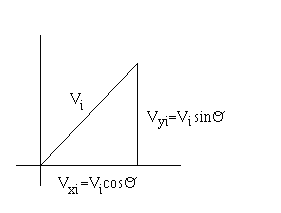 ). Note the picture below. When you know Vi you also know the two component vectors if you know the angle.
). Note the picture below. When you know Vi you also know the two component vectors if you know the angle.Now, to understand this page, you'll have had to had a background in vectors and component vectors. If you haven't, then head on over to the vectors page.
The range equation can be one of the trickiest and most confusing equations...if you let it. It's purpose in life is to tell you how far an object goes if you are given an initial velocity (Vi) and an angle from which it was launched ( ). Note the picture below. When you know Vi you also know the two component vectors if you know the angle.
). Note the picture below. When you know Vi you also know the two component vectors if you know the angle.

So looking back at the first three equations, you know that with those, you can figure out time of flight and then figure out how far an object traveled. Well, why not combine all those equations into one big equation, the Range Equation.
So now I'm gonna start throwing equations at you like the last three pages. Here's what we know

Now I now you can tell just by looking at this that it's going to be fun. So here we go. Do you remember the second equation that we derived? Well here it is if you don't.
Now we're going to make this into a vertical equation.
Once you have this, just start substituting and crossing things off that are equal to 0. Then solve for t. (You'll see why in a minute)
 t+1/2at2
t+1/2at2 +1/2at)
+1/2at) +1/2at
+1/2at =1/2at
=1/2at )/a=t
)/a=tBefore I move on, there's something that I must explain. Let's say that there's an object moving at a constant velocity and you want to know how far it goes after a certain amount of time. Well, this equation would look like this:
Vixis the initial and constant velocity in the x direction. All you have to do is multiply the time versus the velocity. WAIT! Did you say TIME? Don't we have an equation that equals TIME? And didn't I say at the beginning of this page that we have the VELOCITY? Wasn't it equal to Vicos ? Well, let's plug in our time equation and this one into the equation directly above and see what we get. I suspect it will be the RANGE EQUATION!
? Well, let's plug in our time equation and this one into the equation directly above and see what we get. I suspect it will be the RANGE EQUATION!
 )(-2Visin
)(-2Visin ))/a
))/a cos
cos )
) )/a
)/aAlright, so now you're going to ask me about the sine times the cosine thing, aren't you? Well, it's just one of those trig identities and it happens to equal sin2 . Sorry, that wasn't a good explanation, but I don't care. Live with it. So now you have it..the RANGE EQUATION. Now you can either move on to finding the first two equations using calculus or you can do some example problems.
. Sorry, that wasn't a good explanation, but I don't care. Live with it. So now you have it..the RANGE EQUATION. Now you can either move on to finding the first two equations using calculus or you can do some example problems.